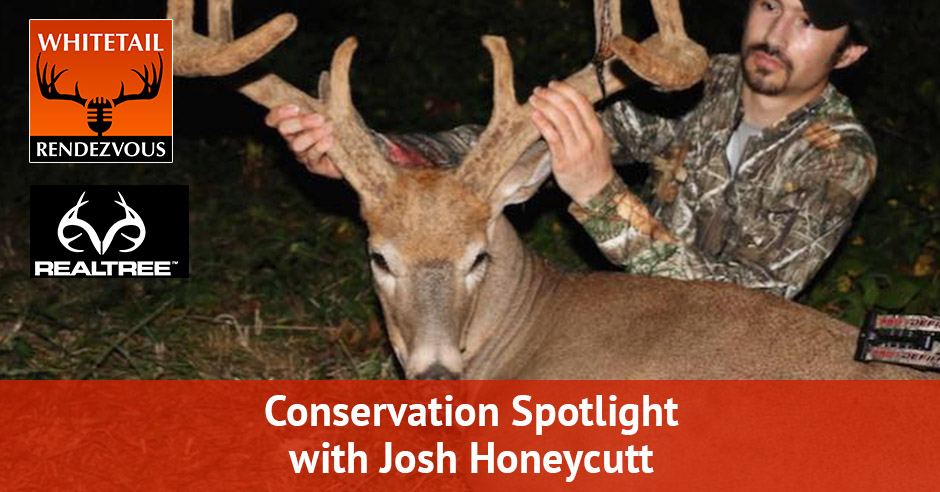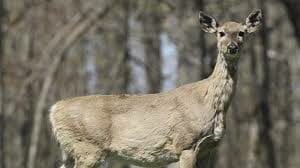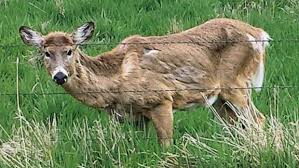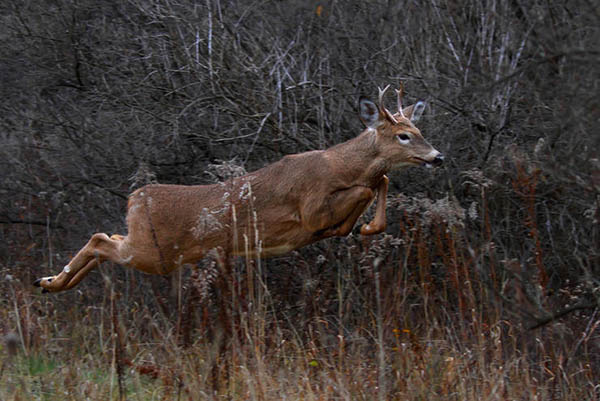
—
Listen to the podcast here:
Conservation Spotlight with Josh Honeycutt
CWD Is A Huge Issue For All Stakeholders
My featured guest is Josh Honeycutt from Realtree. Josh and I are good friends and he has written a couple of articles lately for Realtree in regard to CWD. Josh, we’re going to go over those articles and let people know what they should be concerned about and what they shouldn’t be concerned about. As we talked about in the warm-up, our habits and procedures in the field changed up a little bit. When we’re processing games, it changed up a little bit, but other than that we’re eating venison every single month, twelve months a year. Without further ado, Josh, why don’t you tell the people a little bit about your bio and then we’ll roll right into it.
I’m the Associate Editor and Deer Hunting Editor for Realtree.com. I help write content for that website. I help out with the generic content for social media as well, but my primary concern and duty is Realtree.com. I will say before we dive in with the topic of CWD, I’m not a whitetail or a wildlife biologist. I am simply an outdoor writer, outdoor communicator, outdoor reporter or whatever you want to call me. I’m simply going to be pulling information from a couple of articles that we published in Realtree.com that I wrote. I have a lot of good and knowledgeable sources that we quoted in these pieces.
If somebody read this blog and they say, “I want to go read that article,” let’s tell them how they can get to that right away.
They’re going to both be in the article section under the Deer Hunting nest in Realtree.com. One is titled What We Know About the Recent News of a CWD Cure and the other is Why Chronic Wasting Disease Shouldn’t Scare You Away From Deer Hunting. They can find them both with Google or they can go to the website. Just click through and find it.
Let’s jump in those articles.
The right answer — continue to enjoy deer hunting but handle carcasses with care. Share on XCWD, it’s covered a lot. It gets a lot of press. I do think that is a significant threat to whitetails personally. Is it a significant threat to humans? We don’t know that it is. We don’t have any documented proof that CWD has infected humans. It also has not been ruled out that it could be possible, but we don’t know that it ever happened. While CWD is a big threat for whitetails, we still don’t know how it affects people if it affects people at all. Many people aren’t aware of CWD. Those who are, may not know a lot about it. They may be a little bit unfamiliar with it, but it’s similar to BSE, which is the mad cow disease. I’m sure a lot of people have heard of mad cow disease. CWD is very similar to mad cow disease or BSE. It’s also similar in characteristic to CJD which is Creutzfeldt-Jakob disease which is the human version of CWD. They share very similar characteristics and traits between those. They’re sister diseases but again, we don’t know that the CWD version can jump the barrier and affect humans. What do you want to cover and what area or what questions or concerns would you like to cover first?
I’ve got my kids and my grandkids and I’m hunting in Sauk County, Wisconsin which was the epicenter in Wisconsin of CWDs. Should we not go hunting?
I would definitely not do that. I wouldn’t allow it personally. I’m not a biologist. I am fortunate to have a lot of close friends who are biologists who I rely on for information and they keep me up-to-date. Personally, I would not let CWD scare me away from deer hunting. If I’m hunting in an area which I’m fortunate that I don’t have to, as far as we know, Kentucky is a CWD-free state. I have hunted in CWD states in the past. If I was to hunt in CWD zone, I would not be afraid to harvest a deer. I would not be afraid to eat a deer. I would get that deer tested if I took a deer in a CWD zone. I would get that deer tested and I probably would not eat the deer if it did test positive in case. The CDC recommends that you do not eat a CWD positive deer just to be on the safe side. All of that said, I would not let CWD scare me away from deer hunting. I don’t have children of my own but if I did, I would not be afraid to feed them deer meat as long as I had that deer tested and it didn’t test CWD positive.
How long does it take to get a deer tested? I go out opening day and I knocked down a couple of does and I take him in. How long before I get the announcement that you’re good to go?
 As I know, advancements are being made in that field. The fastest test that I’m aware of is a couple of weeks. If you’re somebody who takes a deer to a processor and you send off to get that deer tested, you still have got to get that deer processed in the meantime. That’s the unfortunate part if you decided you didn’t want to eat that deer if it was CWD positive and you paid a processor to process that deer meat. In the meantime, you sent off the sample to get tested and a couple of weeks later you get it back and it’s positive and you’re out that money. That’s unfortunate but if you’re doing it yourself, if you’re processing your own deer and most of the time I do, I think I only had one or two deer processed in memory.
As I know, advancements are being made in that field. The fastest test that I’m aware of is a couple of weeks. If you’re somebody who takes a deer to a processor and you send off to get that deer tested, you still have got to get that deer processed in the meantime. That’s the unfortunate part if you decided you didn’t want to eat that deer if it was CWD positive and you paid a processor to process that deer meat. In the meantime, you sent off the sample to get tested and a couple of weeks later you get it back and it’s positive and you’re out that money. That’s unfortunate but if you’re doing it yourself, if you’re processing your own deer and most of the time I do, I think I only had one or two deer processed in memory.
Everything I do, I do on my own. If that’s the case, you can go on when you harvest your deer, you can process it if you’re processing your own, put it in the freezer. The fastest test that I’m aware of, and there might be a faster one out there, is you take the lymph nodes out of the deer’s neck and you send them off to a lab. Generally, to my understanding, it’s about two weeks. I’ve never personally done that because I’ve not hunted in a CWD zone in quite some time. I may not have ever. I know I’ve been in CWD states before. I don’t think I’ve ever hunted within a “CWD zone” though. If I was to, that’s the fastest method that I am aware of as far as tests go.
When we hunt, we process our own deer and put them in the freezer and wait for the results. That’s the prudent thing to do and when you think about it, times change and you have to change the time. It doesn’t preclude you from going out and keeping the hunting tradition going. On the scientific side, prion and spiroplasma, a guy from Louisiana, I think your article said. Why don’t we go in and talk about deer, elk, moose and reindeer are the ones that get CWD, is that correct?
Yes, to my knowledge. We did report a while back. A lot of people probably saw the headlines from different media sources talking about how a new cure for CWD had been found. I personally cannot confirm or deny that. I’m not a biologist and I have not looked at the guy who stated that or made that statement. I have not looked at his research. We did reach out to him whenever we wrote this article, What We Know About the Recent News of the CWD Cure. We also reached out to some other individuals in the industry that I would consider experts. We just let everybody say what they had to say. We did not weigh in this piece one way or the other whether we believe that this was a cure or not. We simply relied on the sources that we had and the context that we had who were willing to contribute and let them say what they had to say. Some people agree with Dr. Bastian who was the professor, the researcher who came out with this statement that he would have a cure within a few years or whatever the length of period was.
Most people disagreed with him as far as what the basis or the causation, the causing factor or method of transmission of CWD. Most people would disagree with him based on our findings whenever we reported on this. I’ve got some quotes here that I will read. I’m going to be reading straight from this article that we did. You might have heard the claims or read the headlines that a cure for CWD has been found. A former Louisiana State University neuropathologist, Dr. Frank Bastian, believes he’s on the right road to discovering it and all due to his belief in his research that points to a spiroplasma and not prions as the causative agent of CWD. In other words, he believes CWD is caused by bacteria and not malformed proteins. Most researchers disagree with him. Most researchers believe that it is prions that are the causative agent or the infecting agent and not bacteria.
Dr. Bastian’s research that he has conducted has led him to believe that it is bacteria. We did reach out to Dr. Bastian who had a lot to say and this is Dr. Bastian’s quote, “The point is that we have shown that the bacterium is involved in this disease. In that sense, the door has been swung open and being able to start to control this. The big thing that’s happened to me is I’ve been able to grow the CWD bacterium. I was dead in the water if I could not grow it. I can now characterize it. I can get it in self-reculture. I can develop antibodies to it. I can develop tests and vaccines. This is going to be a big difference for the hunting industry.” There were people who did not agree with Dr. Bastian.
Times change but it doesn't preclude you from going out and keeping the hunting tradition going. Share on XDr. Rowledge, who has been in the CWD field and in that arena for quite some time now, he says, “While there are or could be some interesting aspects in findings underlying Bastian’s work, there are also some very significant challenges. Vastly more important in practical terms the notion or role of bacteria is distinction without difference. If true, nothing about Bastian’s conjecture changes the need to contain the spread of the pathogen. It does not change the enormous costs, debt, and deepening deficit of CWD. It does not change the massively destructive costs of privatizing and commercializing wildlife. It does not change the fact that there are dozens of pathogens and parasites that are amplified by captivity and commercialization.” He goes on to talk about different things. He said, “It does not reverse the disconnection of people from wild species and the natural landscapes that are produce and protect them. It does not change the fact of evolving pathogens and evolving landscapes or the absurdity of trying to find Band-Aid cures rather than designing a policy to stop fostering, incubating and spreading it.”
Another quote was directly from the QDMA. This was their official response to the news that Dr. Bastian comes out with. They said and this is QDMA’s quote, their response, “Chronic wasting disease is caused by prions and the scientific evidence is overwhelming. While it’s important to explore all potential solutions to this series challenge, the spiroplasma theory is not new. It has been thoroughly examined for years without verification. Nothing could be better news for deer hunters than the discovery of a cure for CWD, but the promises that a cure is coming soon have no basis in confirmed science. For now, we must all remain focused on preventing the spread of CWD to new areas.”
The National Deer Alliance, the NDA also had a response, “Please consider the following research which is related to the claim receiving a good deal of publicity that spiroplasma bacteria are the causative agents of transmissible spongiform encephalopathies, TSE like chronic wasting disease. We are encouraged that researchers continue to seek answers about this very complicated disease. We are hopeful that what is learned can help us make prudent decisions about how to manage it for the long-term health of wild deer hunting and the outdoor industry.”
I’m not going to go into every bit of the studies that they pointed to because we quoted these studies in this article. If you want to go in and get the in-depth research that we included in this piece that I’ve been quoting here, you need to go to Realtree.com. It’s titled What We Know About the Recent News of a CWD Cure. You can plug that in Google and you’ll find it. A lot of the research that he pointed to if I’m remembering this correctly, suggested that it was still prions that were the causative agent. I may not be completely correct in that statement, but the best I can recall from when I wrote this was that’s what most of the research, the NDA pointed to. That’s what that research suggests.
 Let’s talk about prion and the spiroplasma. Spiroplasma are bacteria according to that one gentleman but prion is a different pathogen, is that correct?
Let’s talk about prion and the spiroplasma. Spiroplasma are bacteria according to that one gentleman but prion is a different pathogen, is that correct?
Prions are just a malformed protein, they’re not a virus or bacteria. They’re not alive nor dead. It’s a very interesting concept. A lot of biologists, researchers and doctors were referred to prions as the last frontier in biological science. There’s a lot that they don’t know about these malformed proteins, but the majority of people suggest or feel and they have studies and research to back them up. That suggests that CWD is caused by prions. Dr. Bastian believes that the prions are merely a by-product of the disease and that they’re not the actual causative agent. He believes that the actual agent is bacteria. It’s bacteria-based and spread through bacteria. That’s what he feels and believes based on his own findings.
I’m in the woods. Is there any way I can tell that a deer has CWD? He pops up under my treestand and I look at him and say, “That’s a sick deer.” Should I shoot him?
That’s hard to say because the incubation period for CWD is so long. It varies from deer to deer, but some deer can go a year and a half, even closer to two years carrying the disease before they show any symptoms or signs of CWD. It’s hard to say if a deer has CWD or not. From my understanding, if it’s in advanced stages, if it’s progressed, if CWD has become more prominent within the host animal, you can begin to see some symptoms. A lot of times the deer are going to be very malnourished. You’re going to see bones and ribs. A deer might be lethargic. It might seem delirious, just in the way it’s acting. It might not be aware of its surroundings. It might be swaying and it might be stumbling.
Typically, a lot of the times if you see a deer that looks very malnourished or has hardly any meat on its bones. You see a lot of ribs, you see bones, there’s a good chance that while there are other diseases that can have that same effect and can cause that same look in a deer and have the same symptoms, CWD has those symptoms as well. That’s one way you can tell them. If it’s early on in the infection period or during the incubation period, a lot of times they don’t show symptoms and you won’t know it unless you got tested.
The only thing I can say about that question, a friend of mine on his trail camera had a malnourished deer looking at him and he knew it was sick. The DNR said, “If you see that deer, shoot it and don’t touch it. Don’t do anything, just mark it and call us. We’ll come and take care of it because they wanted to see it.” I would recommend to anybody if they see a deer that’s obviously sick, talk to your DNR first. If they do say go ahead and shoot it no matter what the season, then make sure you get that cleared and stay away from it. Don’t do anything to it because that’s not good and we don’t know exactly what’s ailing the deer.
While CWD is a big threat for whitetails, we still don't know how it affects people, if it affects people at all. Share on XI’m taking a step back here. I do want to read one quote here from the NDA. They said, “Research claiming that bacteria are the causative agents of transmissible spongiform encephalopathies has never been reproduced despite extremely rigorous attempts to do so. In blind studies done by the University of Maryland School of Medicine, samples of brain material infected with scrapie along with uninfected samples were searched for spiroplasma and other common bacteria and bacteria-like structures using polymerase chain reaction, PSR and amplification. PSR is a method widely used in molecular biology to make many copies of specific DNA segments. They said that researchers found no evidence that any bacterium, including spiroplasma or any other bacteria type was consistently associated with scrapie infected brain tissue. Thus, concluding that the agent responsible for TSE disease cannot be a spiroplasma or any other new bacterial species.” You can get the source from that quote in the article. Everyone who I reached out to, they still felt that the prion was the causative agent, that it was not bacteria. They did not agree with the news that Dr. Bastian and some other outlets came out with as far as cure being found.
Go read the article, but there’s no evidence of it being transferable to humans was ever to be found. They can’t duplicate in a lab that it is bacteria. I’m not a scientist but I read like you do and listen to people like you do, but there was a big blowup in the media and there was a lot of fear and misinformation shared. That’s why I wanted to have Josh on to share some specific, well-researched, well-documented information about the status of CWD. I know states are limiting the transfer of deer between states unless it’s been processed. You can’t shoot a deer in Minnesota and take it to Wisconsin vice versa, it’s illegal. If they catch you doing it, there are going to be consequences to it. There are a couple of things and the transfer of deer and then captive deer and that huge market of raising deer, not even high fence and shooting deer just a deer market. What are your thoughts on that and what did your research show about CWD in that vein?
I don’t have any information on that. I’m not a biologist. I haven’t looked at study on that. In my opinion and it’s solely my opinion, I would think that any movement of deer whether that deer is alive or dead has the potential to spread infectious agents, however, the case might be. I feel like alive or dead deer can shed infectious agents. If you’re moving those around whether it’s a deer from a deer farm or whether it’s a wildlife agency that has worked with another wildlife agency to help them restock an area of wild deer until we know more or learn more about CWD. Until the researchers and biologists come up with more of a game plan outside of just containment, I feel that any movement of whitetail deer alive, dead, captive or wild, that should be restricted until we have a better handle on CWD.
While there’s no proof that it affects humans, it’s still a significant threat to whitetails. Don’t let anybody tell you that it’s not. There are a lot of people who say, “There’s not one documented death of CWD in deer.” That’s not true. CWD does kill deer and the death rate, the mortality rate of CWD positive deer is much higher than the mortality rate of CWD-free deer. Whenever a deer gets CWD, it’s a very slow death. It’s not visual like EHD, Epizootic Hemorrhagic Disease. You see that it’s everywhere and when it hits, it hits, but that’s a much different animal because EHD, without getting too detailed into it, it’s conducted, or it’s passed on not from deer to deer. It’s passed on through a body flies called midge. The thing about EHD though is that a deer can obtain immunities to it.

Some deer become immune to it and it’s not always fatal. EHD is not an always a fatal disease. Some deer that get it live through it. While there are some researches that suggest there are some CWD-resistant deer to where they don’t ever get it if they are exposed to it, which is a very small sector of the herd from what I’ve been told. A lot of deer that get EHD is not always fatal. They can get it and then live through it and then whenever they live through it, they build up immunities and they can pass on those immunities. While a lot of people say EHD is a bigger threat to whitetails than CWD, that’s not true. It could not be further from the truth. In my opinion, CWD is a big threat. While I’m not going to sit here and say that they should ban all CWD deer. Personally, I will never hunt within inside of a high fenced area, if that gives you my opinion on hunting within high fences. Just purely looking at the moving of wildlife and the moving of captive deer. I think any movement of those animals alive or dead, wild or captive, has the potential to spread the causative agents of CWD.
I’d be more than happy to interview anybody that has information to share about captive deer that whole discussion. I’m a hunter. I’ve never hunted high fence. I don’t know much about the deer breeding but I’d like to be educated.
I’m not a deer breeder and I’m not a biologist to study that. I don’t have a study in front of me saying that the movement of captive deer or even live deer has the ability to spread causative agents. The vast majority of the biologists that I have spoken with and interviewed for pieces that we have done on Realtree.com have been adamant that the moving of wildlife, that the moving of actual captive deer not wildlife, the movement of both of those sectors, captive deer and free-ranging wildlife, both of those so they say, can spread the causative agents. As well as whenever you take a deer and you shoot a deer and you move it from one location to another. That too has the opportunity to spread causative agents or infectious agents of CWD. That’s all I know, not from my own personal research because I’ve never researched it and I’m not a biologist. I’m simply a reporter and outdoor writer who has a significant passion for whitetail deer. Most of whitetail biologists and doctors and researchers in general out there, they do believe that.
Getting back to my point, if you are in the deer breeding industry, I’d love to hear from you. Reach out to me at WhitetailRendezvous@Gmail.com. I’ll have you on the show because I want my great-grandchildren to be able to hunt out on the farm that I hunt. It’s right in Wisconsin and we have issues. It’s been noted as high-intensity CWD area and that’s sad for me because what if all the deer went away? That deer have been part of my life for 53 years. That would be a sad thing.
That’s the thing. They’re still way more about CWD from what I’m told by the authorities and the experts which I’m not one when it comes to CWD. From what I’ve been told, there are still way more out there about CWD that we don’t know than what we do know. That’s where we have to be careful in my opinion. We have to be extremely cautious in my opinion, moving forward until we do know more about it. Until we do know how to respond to it and what the best management plan is, I think a lot of the biologists, I know there’s a lot and I’m not going to get into this aspect of it now. I know there’s a lot of conflict and disagreements out there of the methods of containing CWD going in and killing deer, this or that. I’m not going to get into all of that, but I do think until we know more about it, about the only thing, in my opinion, we can do is try to contain it.
What the best method is or what the best methods are for containment, I’m not going to discuss that because that’s not something I’m an expert in. I don’t have research on that in front of me or anything like that, but CWD does kill deer despite what people try to say. It is a significant threat to deer hunting and it’s something that we, as an industry, whether you’re captive breeding industry, captive herd industry or you’re a guy who loves to hunt free range and whitetails. The industry as a whole has got to come together to help fund the research for CWD. That way we don’t lose the resource moving down the line and in the future.
Josh, thank you so much for being a guest on the show and I look forward to the next time.
Thank you. I appreciate you having me on.
Important Links:
- Realtree
- Realtree.com
- What We Know About the Recent News of a CWD Cure – article
- Why Chronic Wasting Disease Shouldn’t Scare You Away From Deer Hunting – article
- WhitetailRendezvous@Gmail.com
- https://www.Realtree.com/Deer-Hunting/Articles/What-We-Know-About-The-Recent-News-Of-A-CWD-Cure
- https://www.Realtree.com/Deer-Hunting/Articles/Why-Chronic-Wasting-Disease-Shouldn-t-Scare-You-Away-From-Deer-Hunting
About Josh Honeycutt
 Josh Honeycutt is a back-country deer hunter from Kentucky that grew up slinging arrows and bullets at pressured river bottom whitetails. If it’s deer or turkey season, you’ll find him high in an oak tree or sitting up against one. And he enjoys spending that time in the outdoors with his wife, Kathryn, as well as the rest of his family and friends.
Josh Honeycutt is a back-country deer hunter from Kentucky that grew up slinging arrows and bullets at pressured river bottom whitetails. If it’s deer or turkey season, you’ll find him high in an oak tree or sitting up against one. And he enjoys spending that time in the outdoors with his wife, Kathryn, as well as the rest of his family and friends.